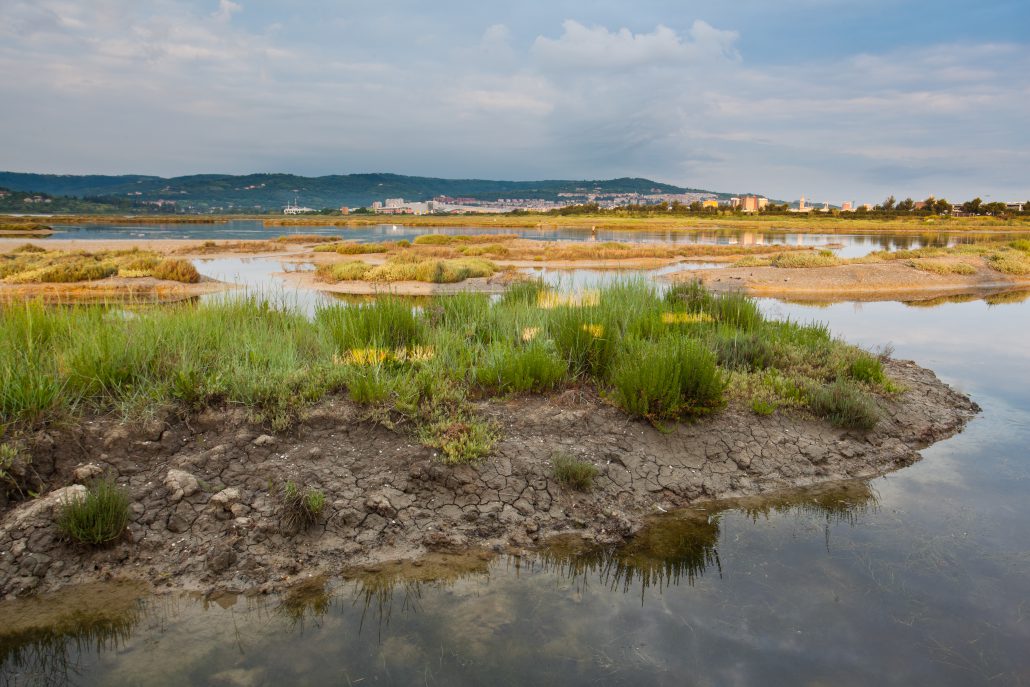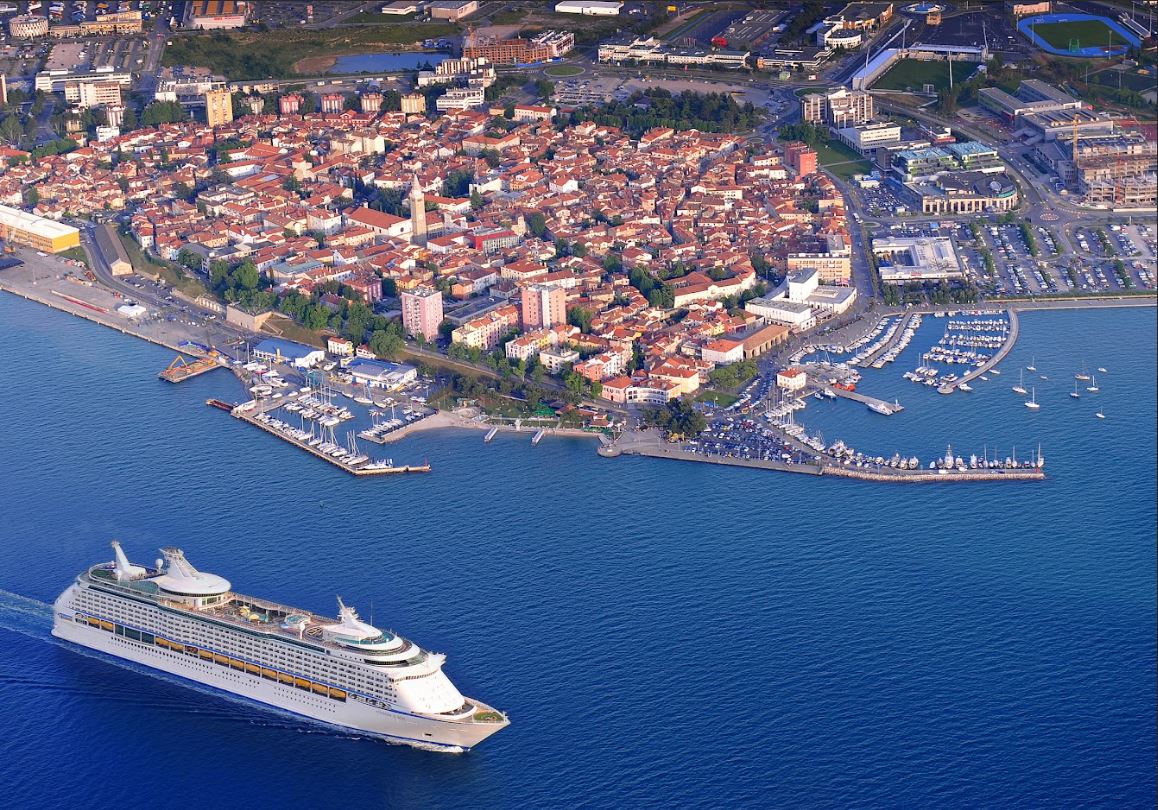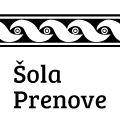A hike along Athena’s shield
Enter through the gate with the sun. Take a walk among its fountains. Have a look at the palaces from the times of the Venetian Republic. Climb the tower with sunny views.
Enter through the gate with the sun
Start the circuit of Koper through the picturesque streets with Venetian Republic architecture at the mighty Muda Gate (1). The main and the only preserved gate of the once twelve gates of the town walls greets you in a form of an ancient triumphal arch in the town of a hundred suns. You can also find the sun here – a symbol from the coat of arms. As you enter through the gate, which is already 500 years old, you find yourself on Prešeren Square (2). Let the exploration really begin here.
(Recommended time for viewing: 5 minutes)
Among Koper fountains
Koper was once an island. Da Ponte Fountain (3) stands at the connection point between the old island part of Koper and the mainland. The fountain got its preserved Baroque design in 1666. The square in front displays a bronze cast of the island of Koper, made according to plan from the year 1619. The cast invites you to discover the stories of the past – of the town that grew on the island and was at first inhabited by goats.
Continue along Župančičeva ulica street (4). Here, the Carli Palace (5) impresses with its rich history. The inner courtyard boasts the oldest dated fountain in Slovenia.
(Recommended time for viewing: 5 minutes)
Along the street of master craftmen
If you continue along the route, you will get to the main promenade of the old town. The street is still called Čevljarska ulica (6) (Cobbler St.) because there used to be many cobblers’ workshops there. Otherwise also known as Calegaria, it has been inhabited for centuries by merchants and artisans who have their workshops on the ground floors of Gothic and Baroque buildings with interesting portals and other architectural details
A Tip: Art lovers like to enter the Meduza exhibition and sales gallery here, which presents top works by established and younger Slovenian artists.
To the square with a magnificent palace
Titov trg square (7) is the site of the most important sights of Koper. The largest is the Praetorian Palace (8), the former seat of the town rulers. The Koper Tourist Information Centre (9), where you can arrange for a guided tour of the palace, is located here. Opposite the palace is Loggia (10), once intended for bourgeois debates. Continue learning about Koper’s treasures in the Cathedral of the Assumption of the Blessed Virgin Mary (11). The church is also known as the Cathedral of St. Nazarius and houses valuable works by the famous Venetian painter Carpaccio. Before leaving the lively square, venture up the Bell Tower (12) and enjoy the views of Koper from a sunny perspective.
(Recommended time for viewing: 2o minutes)
A Tip: There is a café in Loggia, which is considered to be the oldest operating café in Slovenia. A coffee stop allows you to observe the beauty of the main town square and the authentic pulse of the city.
To times of magnificent Koper
From the main square, turn into Kidričeva ulica street and continue to Muzejski trg square. Here you can admire an outstanding example of the early Baroque Belgramoni-Tacco Palace (13) where the Koper Provincial Museum (14) is located. Experience the splendour of the Renaissance and Venetian periods of the town displayed in the collections. Just a few steps down Kidričeva ulica you will find a collection of legendary Tomos motorcycles (15) with stories of a factory that used to be Koper’s pride during socialism. At the end of the street, a view of Carpacciov trg square opens on the left (16). There you will find the Column of St. Justine (17), which commemorates the great naval battle of the 16th century. In the near Pristaniška ulica street, Taverna (18) is located – a former salt warehouse, which is now a popular event place.
(Recommended time for viewing: 2o minutes)
Tastes of Istria
Continue along the palm tree street. It takes you to the marketplace (19), where the gifts of the sea and the land, the town and the countryside come together. Try local delicacies such as fuži with truffles, frittata with wild asparagus, prosciutto or bobiči. Taste Istrian sweets such as fried fritule and hroštole and other Istrian specialities.
To reach the marketplace, just walk to the Muda Gate (1), where you started your tour of the town, which arose on the spot where the goddess Athena lost her shield in the sea.
(Recommended time for viewing: 2o minutes)
A Tip: The tastes of Istria go well with the noble taste of wines of the Primorska wine-growing region. A good kilometre from the centre of Koper, Vinakoper wine cellar is located with a shop called Hiša refoška, where the wine offer is complemented by various local gourmet specialities.
Suggetion for a hike
The Škocjanski zatok nature reserve
Visit the Škocjanski zatok Nature Reserve on foot, by bike, alone or with a guide. The entrance to the reserve is only 2 km from the centre of Koper. More than 220 species of birds and many other rare and endangered plant and animal species live in the largest semi-saline wetland in Slovenia. You can get to know them on a circular educational path or from special observatories. The boškarin (Podolian cattle) and Camargue horses can also be seen here. You can also manage the trail on horseback if you want.
More information: TIC Koper; www.visitkoper.si

1. Muda gate
The town gate, erected in 1516, was used by those visitors who came to the former island across the bridge at the Lion Castle or later along the embankment from the mainland. The Renaissance style gate shows heraldic decoration. In addition to the sun, the symbol of the town, there are also lion heads. A smaller, auxiliary gate is located besides the main gate.
Pristaniška ulica 47
2. Prešernov trg square
The square next to the most important town gate was once known as Da Ponte Square, probably named after the former podestà Lorenzo Da Ponte, after whom the fountain in the square is also named. Perhaps its name was more influenced by the proximity and the importance of the bridge (ponte), which, together with the Muda Gate, connected the former island to the mainland. Today, the square is named after the poet France Prešeren.
3. Da Ponte fountain
The fountain, first mentioned as early as 1423, stands on the site of a former aqueduct, which fed water to the then island of Koper. The fountain got its present-day Baroque appearance in 1666, when it was rebuilt by the podestà Lorenzo Da Ponte. The octagonal water pool with an arch, which represents the bridge, is additionally decorated with pyramids, coats of arms, stone faces, other motifs, and a fence.
Prešernov trg
4. Župančičeva ulica street
The street, named after the Slovenian poet Oton Župančič, is full of interesting palaces.
Here, before your eyes, are the Venetian-Gothic Filiputti House from the 15th century (house no. 17), a medieval residential building from the 14th century (no. 23), the Baroque Vida Vidacovich Palace from the 15th century (no. 28), the Venetian-Gothic two-storey Pechiari Palace built in the 14th century, which later added Baroque style elements (nos. 35 and 35a), and a Baroque bourgeois house from the 18th century (no. 41). Next to the stairs leading from Župančičeva ulica street to Gortanov trg square is the Baroque Gerosa Palace (Gortanov trg 11 / Župančičeva ulica 20).
5. The Carli palace
The Baroque palace has a façade with a balcony and a semicircular portal. The picturesque inner courtyard of the palace, decorated with frescoes, boasts the ring of a fountain from 1418. The palace of Gothic origin belonged to the fraternity of St. Clement. In the 18th century, it was home to the Carli family, one of the oldest noble families in Koper. Gian Rinaldo Carli, a count, encyclopaedist and enlightener, was born here in 1720 . Today, the palace is the seat of the Self-governing Italian Community of the Coastal Region
Župančičeva ulica 39
6. Čevljarska ulica street
Have a look at the interesting buildings. Here are the Biscontini – Minca House from the 16th century with a Renaissance portal (house no. 30), the Baroque Pellegrini de Favento Palace from the 17th century (no. 25), and a Neo-Gothic palace from the 19th century (no. 23). Just opposite stands the De Franceschi Palace (house no 38). A little further on there is an apartment building from the 18th century. It consists of a multi Gothic building units, connected by a small inner courtyard (no. 5). You will find the Barbabianca Palace with a richly segmented façade in the dead end. Before entering the main square, check out the Orlandini House with a Baroque portal ( no.3) and the painted façade of the Galli House (no. 1), which is joined with the Praetorian Palace.
7. Titov trg square
The square, considered one of the most beautiful town squares in the former Venetian territory, has been the centre of the town and a venue for decision making for centuries. It is surround by the church from the 11th century, the tower, which was standing here already in the 12th century, a palace from the 13th century and several other palaces. The square is the crossroads of paths and the centre of town life.
8. The Praetorian palace
The Praetorian Palace was built in the 13th century and got its present appearance in the middle of the 15th century. The building is dominated by the late Gothic-Renaissance style and Venetian Gothic. The palace is decorated by an external staircase, an external balcony, a distinct façade, a statue of Lady Justice with her sword and the many decorative coats-of-arms with carvings from the history of Koper. Visitors from all over the world recommend visiting Koper’s most famous palace. It boasts a certificate of excellence awarded by TripAdvisor.
Titov trg 3
9. Koper Tourist-Information Centre
The TIC in the Praetorian Palace offers all the information about the sights and tourist offer of Koper and Istria, about excursions around the area, accommodation and events. Here, you can also arrange a tour of the interior of the Praetorian Palace and other guided experiences
Titov trg 3 T: 05 664 64 03
10. Loggia
Opposite the Praetorian Palace, the Gothic town hall Loggia has stood there since the 15th century. It is decorated with the statue of Virgin Mary with child, erected in memory of the devastating plague in 1554. The Loggia Palace was intended for citizens’ debates, which were then considered by the town council. In the middle of the 19th century, a café, which is known as the oldest in Slovenia, opened its doors on the ground floor.
Titov trg 1
11. The Cathedral of The Assumption of The Blessed Virgin Mary
The cathedral church, also known as the Cathedral of St. Nazarius, is nowadays located on the spot where a Romanesque basilica stood during the classical era. The current church was supposedly built in the 11th century and since then it has undergone numerous renovations. The cathedral was expanded in the first half of the 18th century. Nowadays, it is famous for being one of the biggest churches in Slovenia. Inside the church, you can admire the artworks by Vittore Carpaccio and the marble headstone of St. Nazarius – the patron saint of the town and the bishop of Koper from the 6th century. Next to the church is the baptistery – the Rotunda of Our Lady of Mount Carmel, which was supposedly built between the 10th and 12th centuries.
Titov trg
12. The bell tower
The bell tower or a tower with characteristic features of a Romanesque fortification architecture is said to have stood as early as the 12th century. It was reconstructed in the 15th century, when the previously independent tower was joined to the church. It was given its present appearance in 1664. The tower houses the bell of St. Nazarius and is considered the oldest working bell in Slovenia. It was cast in Venice in 1333. The large clock was constructed in 1463. The staircase of the tower, which was connected via an arched bridge to the palace of the vidames, was used to summon citizens and announce the declarations of podestas (representatives of municipal authorities).
Titov trg 3
13. The Belgramoni-Tacco palace
In addition to the collections of the Koper Regional museum located in this 17th century palace, you can also admire the museum garden, which was converted into a lapidary. A beautiful staircase leads from the atrium to the first floor with a large hall and two lounges. The garden and the museum hall provide wonderful backdrops for events.
Kidričeva ulica 16
14. Koper regional museum
The museum, which is located in the Belgramoni Tacco Palace, shows the town’s development from prehistoric times to the present in a permanent exhibition called The Heart of Koper. Selected works of art can be viewed in 3D by prior arrangement. The museum’s Antique Lapidary offers a collection of Roman stone monuments. The museum also takes care of the ethnological collection, exhibited in the late Gothic house on Gramscijev trg square.
Kidričeva ulica 19, T: 041 55 66 44
15. The Museum of Tomos history
There is no house in Slovenian Istria where at least one product of the Tomos motorcycle factory would not find its place. Legendary mopeds, popular especially among young people, and motorcycles that reaped sporting success are on display in an interesting collection of industrial heritage. The history of the factory is also presented.
Kidričeva ulica 41, T: 041 753 232
16. Carpacciov trg square
The square, called Pristaniški trg or Piassal del porto by the locals, is named after Vittore Carpaccio (around 1465, Venice – 1525/26), a famous Venetian painter. There is a house in the square where he spent his last years. In addition to the altar picture and organ wings in the Cathedral, he also painted two canvases, which are now in the Koper Regional Museum. His painting ‘The Solemn Arrival of the Venetian Podestà Sebastiano Contarini in Koper’ is the first group portrait in Istria.
17. The pillar of St. Justina
The pillar from 1572 commemorates the important naval Battle of Lepanto, in which the Turks were defeated in 1571. The Koper galley also took part in the battle. The white limestone statue that completes the pillar bears the shield of the Gustinian family. Andrea Gustinian was both the captain and the podestà who had the monument erected. It originally stood on the pier of the town’s manderaggio, but was erected on the present-day site in 1935 . At that time, a 15th-century fountain, brought from Venice, was also placed on the square.
Carpacciov trg
18. Taverna
The salt warehouse was built in the 17th century along the town walls and the old Koper manderaggio. It showed Koper’s economic supremacy over Istrian towns. Since Koper remained loyal to the Venetian doge after the first disputes with the Venetian Republic, it gained the right to a monopoly port of salt and the exclusive right to import salt to the mainland in the area between Gradež and Pula as early as 1182. Nowadays, Taverna is a popular venue for various events.
Pristaniška ulica 1
19. The Marketplace
At the entrance to the old town is the marketplace, which is not only a marketplace but also a place for socializing, discussion and entertainment. There is a well, created by an Japanese artist Masayuki Nagase. From here it is only a short way to Hlavaty Park, where the busts of six coastal revolutionaries and heroes face the sea.
Pristaniška ulica 2
- 11. Muda gate
- 22. Prešernov trg square
- 33. Da Ponte fountain
- 44. Župančičeva ulica street
- 55. The Carli palace
- 66. Čevljarska ulica street
- 77. Titov trg square
- 88. The Praetorian palace
- 99. Koper Tourist-Information Centre
- 1010. Loggia
- 1111. The Cathedral of The Assumption of The Blessed Virgin Mary
- 1212. The bell tower
- 1313. The Belgramoni-Tacco palace
- 1414. Koper regional museum
- 1515. The Museum of Tomos history
- 1616. Carpacciov trg square
- 1717. The pillar of St. Justina
- 1818. Taverna
- 1919. The Marketplace





